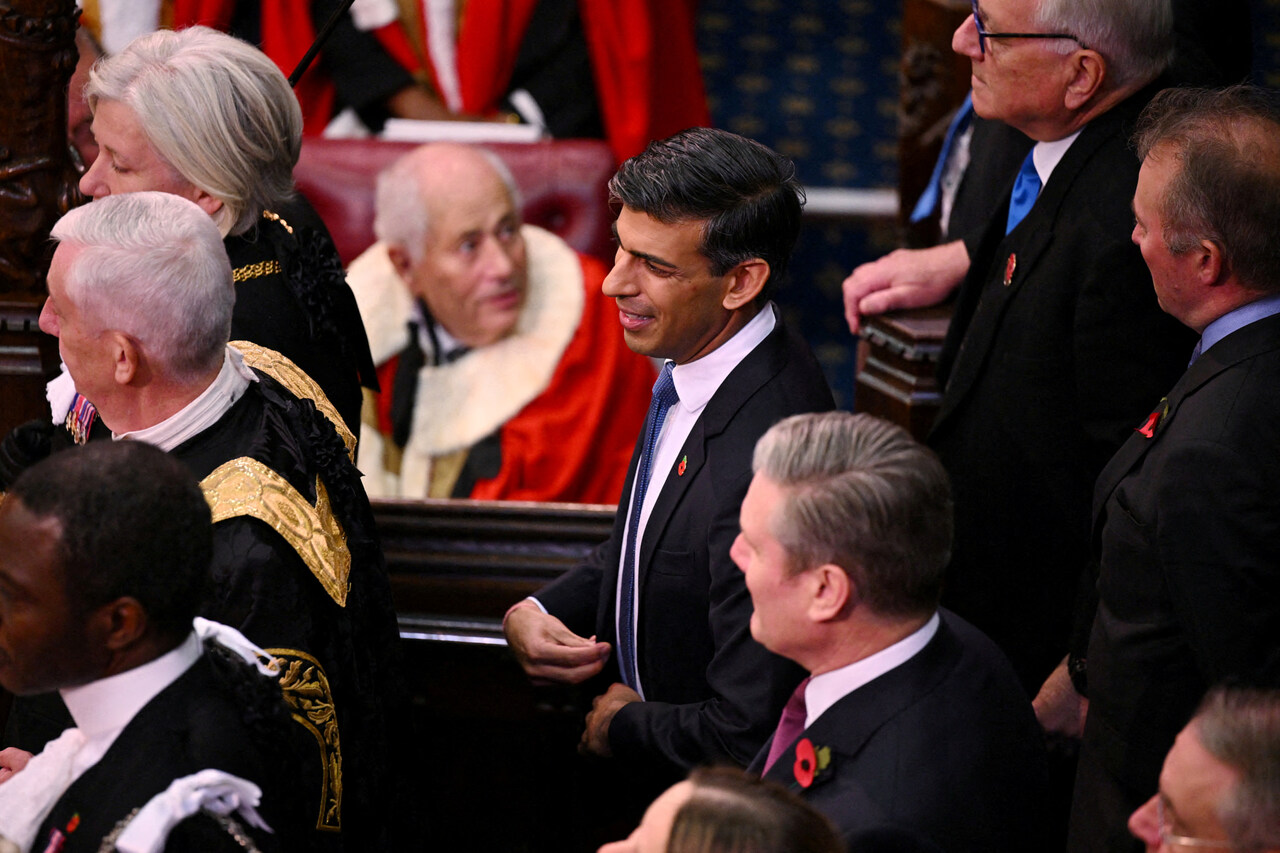British Parties Start Vying for Voters Ahead of the 2024 General Election
The “long campaign” before the 2024 UK General Election was inaugurated by party conferences in September and October as well as the last King’s speech in the current parliamentary term and a comprehensive cabinet reshuffle in November. Since the fall of Boris Johnson’s government in the summer of 2022, there has been continuous infighting among the Tories. In the competition between the parties, Labour, led by Keir Starmer, is the favourite. The upcoming election will decide whether the UK continues with or changes the post-Brexit strategy.
 POOL New / Reuters / Forum
POOL New / Reuters / Forum
Electoral Dynamics Since 2015
In the years 2015–2019, the beneficiary of the change in the general electorate was the Conservative Party. Its positioning as the “party of Brexit” systematically strengthened its national-conservative wing at the expense of the liberal-centrist one. In the case of Labour, the changes under the leadership of Jeremy Corbyn (2015–2019) resulted in the strengthening of the radical left-wing at the expense of the centrists. These processes culminated in the electoral victory of the Conservatives under Johnson’s leadership in 2019. They won thanks to their building a coalition of provincial middle-class conservative voters hostile to Corbyn with socially conservative, pro-social, anti-immigration and Eurosceptic working-class voters from post-industrial constituencies (“Red Wall”). The latter were won over with the pledge of using Brexit to unblock socio-economic reforms aimed at, among others, limiting immigration, remodelling the labour market, and levelling out regional development differences.
Starting Positions and Party Programmes
The taking over in November 2022 of the prime ministership by Rishi Sunak—without obtaining a clear mandate either from voters or party members—did not manage to end the Tories’ infighting. As a result, on 13 November Suella Braverman, the Home Secretary and the main representative of the right-wing of the party, was dismissed from the government, while many representatives of the centre-left wing returned to the cabinet, including Lord David Cameron (former prime minister, 2005–2015) as Foreign, Commonwealth and Development Secretary. The Conservative Party Conference, the last King’s speech in the current parliamentary term, and the Autumn Budget Statement in September-November indicate Sunak’s intention to regain the support of middle-class voters (e.g., through tax cuts, continuation of liberal immigration policy, and rapprochement with the EU), while distancing himself from the most important demand of the right-wing of the party to limit legal immigration and deport irregular immigrants to Rwanda.
Since 2019, the Labour Party, under the leadership of Sir Keir Starmer, has been undertaking to regain its traditional electoral base among working-class voters (who massively supported Brexit), Jewish voters (who have been discouraged by the structural antisemitism in the party since Corbyn’s leadership), and Scottish voters (lost to the Scottish National Party). At the same time, Starmer has been trying to maintain his party’s lead in support among young and progressive voters gained under his predecessor. To this end, Starmer’s message is nuanced regarding the Palestinian-Israeli conflict (moving away from a distinctly pro-Palestinian one under Corbyn) or Brexit (emphasising that it does not exclude closer cooperation with the EU). In the economic field, Labour presents a programme similar to the Tories, combining moderate tax cuts with subsidising public services, especially the National Health Service.
Starmer has also been messaging a general continuation of the foreign and security policy of his predecessors, including the modernisation of the British armed forces and the expansion of nuclear deterrence, treating China as a systemic competitor and—what is particularly important for Poland—supporting Ukraine and containing Russia.
The dynamics of the “long campaign” are also influenced by the prospects of the Scottish National Party (SNP) and Liberal Democratic Party in the upcoming election. After a period of peak support for the SNP during the COVID-19 pandemic, last year a rapid decline in its poll ratings began (loss of every fifth voter since Autumn 2022). It was caused by, among others, financial scandals, the failure of the second independence referendum project, and radical progressivism (Gender Recognition Reform Bill 2022). The Liberal Democrats were electorally marginalised for abandoning their programme in favour of a coalition with the Conservatives (2010–2015) and supporting a repeat of the Brexit referendum (2017–2019). Currently, however, they are the strongly benefiting from the decline in public support for leaving the EU, the government’s post-pandemic problems with managing the health service and the economy, and the increase in the cost of living. This has led the Lib Dems to regain their historical position as the third-strongest parliamentary party.
Fields of Competition in the “Long Campaign”
According to polling, British voters are focused on inflation and the cost-of-living crisis, record-high mortgages and energy costs, problems in the National Health Service, as well as the unprecedented scale of both legal and irregular immigration (1.3 million and 150,000 people, respectively, in 2022–2023). Structural or foreign causes of the listed economic problems limit the freedom of politicians to make election pledges. This results in an increasing shift in party competition to immigration policy, which is becoming a key political cleavage. This is because the issue combines problems as diverse as the increasingly difficult access to public services, cultural change, and social cohesion, with the future of the labour market based on the import of low-cost foreign workers and wage pressure on British ones, as well as the scope of national sovereignty in fighting irregular immigration. This policy will also be key to assessing the credibility of the Tories, who have consistently promised to limit immigration in every parliamentary campaign since 2010.
Since the fall of Johnson’s cabinet, Labour has been trying to present itself as a more united and competent party than the Tories. This has resulted in a steady advantage in the polls for the former over the latter (about 45% to 25%, respectively). According to electoral analyses, such a result could deprive the Tories of up to 300 of their 360 current seats (including Sunak’s). This scenario was made more credible by eight House of Commons by-elections in 2022-23 in which there was a significant increase in support for Labour and the Lib Dems, absenteeism among pro-Brexit voters, and tactical voting. The last phenomenon involved centre-left voters shifting support to whichever party had the greatest chance of depriving the Tories of their seat in a given constituency.
Conclusions and Perspectives
From 2022, the programmes of the two dominant parties have generally been converging towards the 2015 centre-left consensus. As a consequence, the importance of immigration policy has been increasing as one of the last fields in which the Conservative Party has been able to undertake to regain the attention and support of pro-Brexit voters, although in this field it also competes with radical Eurosceptics. Despite polls indicating a Labour victory, its scale measured in seats may be significantly different from the result measured in votes. This is due to the need to obtain relative majorities in each of the 650 constituencies separately. The outcome of the “long campaign” will therefore depend on both the Tories’ measure of success in holding onto their 2019 voters and on Labour’s ability to maintain an image of unity and discipline.
The liberal-centrist wing dominating Sunak’s government seems focused on defending 200 seats in the south of England at the expense of those taken over from Labour in 2019. This moves the inter-party competition to the centre and left of the political scene, but exposes the Conservatives to competition from the Reform Party (formerly the Brexit Party), which in polls took over 20% of Tory voters from 2019. These changes also question the loyalty of the Tories’ right-wing to the government. The realisation of the worst-case electoral scenario for the Conservatives would lead to the creation of a new party with a much more right-wing and anti-immigration platform.
A post-election Labour Party parliamentary majority is threatened primarily by strong internal divisions over the ideologically linked issues of immigration, the minority agenda, and the Palestinian issue. In turn, the prospect of a majority Labour government is favoured by the forecasted decline in support for the SNP. The challenged dominance of this party in Scottish politics has been an important electoral obstacle for Labour in gaining a majority in the House of Commons since 2007.
What is crucial for Poland and the EU is that Starmer has a strategy of adopting the most important elements of Conservative foreign policy, including support for Ukraine and the permanence of Brexit. Thanks to Sunak’s new opening in relations with the EU, Labour will be able to cooperate more easily with the Union in selected fields (e.g., harmonisation of sanitary and phytosanitary regulations). However, Starmer’s statements from autumn this year communicate that Britain will remain outside the EU’s common market and customs union, and will continue to strengthen links with the Indo-Pacific. Although all major parties support Ukraine, the depletion of military stockpiles will make the post-election continuation of this policy dependent on the expansion of the UK’s military-industrial potential. Due to pledged social spending, it will be even more difficult financially for the Labour government than for its predecessors.




_Easy-Resize.com.jpg)
